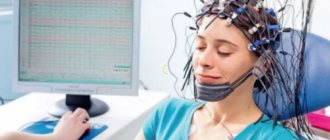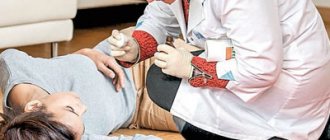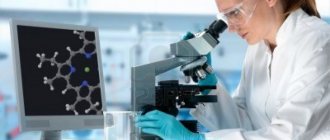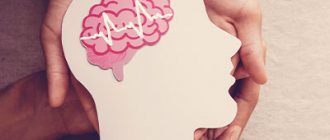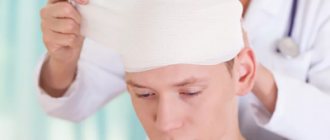Epilepsy is a neurological disease that affects the brain. Characterized by periodically recurring attacks of convulsions. This condition reduces the quality of life and negatively affects other body systems. According to statistics, every 100 people on earth suffer from epilepsy. At present, it has not been possible to determine the definitive causes of the disease.
At the Yusupov Hospital, experienced neurologists and epileptologists diagnose and treat sleep epilepsy. For this purpose, modern medical equipment and proven quality drugs are used. Individually selected therapy allows you to achieve positive results in a minimum amount of time.
What is epilepsy
Epilepsy attacks often occur at night. In this case, a group of neurons in the focus of excitation is activated. This provokes the appearance of convulsive syndrome. Epileptic seizures occur more mildly during sleep. Depending on the period of sleep the seizures occur, the following types of seizures are distinguished:
- Generalized. Characteristic of the period of awakening. At the same time, patients shudder. This form of seizures occurs in people of different ages. Goes away on its own without treatment. One of the reasons for the development is considered to be a failure of the nervous system, which is eliminated with age.
- Frontal. The pathological focus is localized in the frontal parts of the brain. Cramps occur during sleep. This form of epilepsy is hereditary. Characteristic of adolescence. Among the causes of frontal lobe epilepsy are the effects of psycho-emotional stress.
Expert opinion
Author: Georgy Romanovich Popov
Neurologist, Candidate of Medical Sciences
Epilepsy is one of the common neurological pathologies. Doctors distinguish different forms of seizures. One of them is sleep epilepsy. According to statistics, nocturnal attacks occur in 30% of patients. Convulsions during sleep are characterized by less severity compared to other forms of the disease. Nocturnal epilepsy is typical for children over 5 years of age. In rare cases, the disease will persist into adulthood.
Doctors at the Yusupov Hospital carry out a full range of diagnostic measures necessary to detect nocturnal seizures. For this, modern methods are used - EEG, CT, MRI. Based on the examination results, neurologists and epileptologists at the Yusupov Hospital develop an individual treatment plan. The drugs used are included in the list of the latest European standards for the treatment of nocturnal epilepsy. In addition, patients are provided with personalized preventive recommendations to reduce the risk of developing relapses of convulsive syndrome during sleep. The hospital's doctors treat both adults and children. An individual approach allows you to achieve positive results in a minimum amount of time.
Treatment
Different types of epilepsy require different treatment approaches. Depending on the type of epilepsy the doctor is dealing with, he will use different diagnostic methods and treatment options. In some cases, even an accurate diagnosis of epilepsy does not imply the prescription of therapy for the patient. The fact is that treatment must be tailored to each specific case. This means that the doctor needs to take into account all the nuances. Up to the financial capabilities of the patient. Not to mention the fact that all possible risks must be carefully and adequately assessed, since many drugs have a number of severe contraindications and side effects. The form of the attacks should also be taken into account. Patients who have had a mild form of epilepsy without seizures are usually not prescribed medications. Even with an accurate diagnosis. In general, the patient’s condition may cause refusal of drug treatment. Drugs may not be prescribed if a person has had their first epileptic attack and has not experienced seizures, lost consciousness, or performed uncontrollable actions. Seizures of varying duration and frequency are treated with medication, but only if they threaten the patient's health or have a detrimental effect on his life. Non-convulsive seizures that occur no more than once a year are not treated with strong drugs. The success of treatment depends not only on the drug used, but also on other factors. In the treatment of epilepsy it is necessary to be guided by existing general principles and standards of therapy.
If a patient has been diagnosed with epilepsy but does not experience seizures or other severe symptoms, they do not need to take medications. It will be enough to simply avoid factors that can provoke seizures. Although there are no specific methods for preventing epilepsy without seizures, the following general recommendations should be followed:
- maintaining a healthy lifestyle;
- refusal to drink alcohol, smoke, take drugs; moderate physical activity;
- good nutrition and rest.
It is important to exclude any physical and mental fatigue, stress and emotional turmoil, to ensure the most favorable atmosphere in the patient’s environment. Strict adherence to the daily routine is a guarantee of recovery and well-being. The patient should make a schedule for the whole day, and also take into account the fact that he now needs a full night's sleep. Do not neglect rest, otherwise epilepsy without seizures can develop into a more complex and dangerous form. Not only the patient, but also his loved ones need to work to get rid of all irritating factors. It is important to be attentive to the patient's condition. Sometimes watching from the outside can help avoid a lot of problems. It will not be superfluous to talk and discuss the patient’s well-being. After all, fatigue that does not go away even after rest or sleep, dizziness, and depression can be dangerous symptoms. Treatment of epilepsy without seizures also includes systematic check-ups and examination by doctors. Get the necessary tests, take medications that will reduce the manifestations of epilepsy without seizures. Don't let illness affect your life. Epilepsy is not a death sentence. People with this disease lead full and quite active lives. Attentiveness to oneself, assessment of one’s capabilities and self-acceptance are important aspects for the rehabilitation of a patient with epilepsy. It must be remembered that modern medicine has not stopped searching for the best methods of treating and preventing this disease.
Causes of epilepsy during sleep
To date, the definitive causes of nocturnal epilepsy attacks have not been fully studied. Among the main provoking factors are:
- insufficient oxygen supply to the brain;
- history of birth trauma;
- brain tumors;
- infectious and inflammatory diseases;
- intrauterine development disorder;
- history of traumatic brain injury.
Patients suffering from nocturnal epilepsy are advised not to reduce their sleep duration. This can provoke an exacerbation of the disease. At the Yusupov Hospital, doctors pay special attention to the causes of attacks. In this way, it is possible to influence the etiological factor and provide more effective treatment.
Disease prognosis
The disease can have different forms and nature. Short-term seizures do not damage brain cells, unlike long-term seizures, which can cause the death of nerve cells in the brain. Sudden loss of consciousness has a negative impact on the child's health, which can lead to injuries and accidents.
As the disease develops, the child may experience psychological problems - he may begin to fear seizures, which may result in panic attacks.
Symptoms of nocturnal epilepsy attacks
Among the main pathological signs of nocturnal epilepsy are:
- cramps, which can also occur during the daytime;
- nausea, possible vomiting;
- indigestion;
- severe headaches;
- sudden awakenings;
- reproduction of unusual sounds during sleep;
- facial distortion.
The duration of seizures varies. On average, cramps last for 2-5 minutes. Most often, patients do not remember what happened at night. In rare cases, patients are able to describe the sensations they experience. Other symptoms of nocturnal epilepsy include:
- muscle pain;
- bruises and abrasions on the body, the origin of which patients do not remember;
- involuntary urination during seizures;
- tongue bite;
- traces of blood on the pillow after waking up.
If the above symptoms appear, it is recommended to consult a doctor for examination.
Childhood epilepsy - sources of the disease
Is epilepsy treated in children? Yes, rapid identification of risk factors makes it possible to stop attacks in the early stages.
Risk factors:
- brain tumors;
- past illnesses - encephalitis or meningitis;
- disturbances in the functioning of the liver and kidneys;
- imbalance of mineral metabolism in the body.
Symptomatic manifestations of epilepsy in children are more difficult to diagnose than in adults. It is generally accepted that this disease is always accompanied by seizures, but in the case of a child this is not always the case. For example, if your child suffers from frequent headaches or nightmares, this is a reason to go to the doctor and get diagnosed. The disease is diagnosed by undergoing magnetic resonance imaging (MRI).
Epileptic seizure: main differences from ordinary fainting.
- The reaction of the pupils - they stop constricting when interacting with directional light.
- Spontaneous uncontrollable seizures.
- Duration of the attack. If paroxysmal seizures last more than 5 minutes in a child and are repeated many times, and the break between them is less than an hour, this is a very alarming symptom. In this case, you should immediately seek medical help.
Classification of epilepsy attacks during sleep
Epilepsy during sleep is classified into the following types of seizures:
- Frontal. They are characterized by dystonic symptoms, complex motor activity, and rotational movements. In rare cases, they are accompanied by vocal manifestations.
- Occipital. This type of epilepsy during sleep is characterized by blurred vision, vomiting and severe headaches.
- Temporal. Accompanied by complex motor manifestations.
The following conditions can be classified as nocturnal epilepsy:
- Sleepwalking. The symptoms of the disease are known to many. Sleepwalking is accompanied by sleepwalking, nocturnal enuresis, and nightmares. Most often occurs in childhood. In rare cases, sleepwalking occurs throughout life. Aggressive behavior upon awakening is considered a characteristic sign of the disease. Patients do not remember the events that occurred during the attack.
- Parasomnia. This condition is characterized by twitching of the lower extremities when falling asleep, as well as temporary immobility during awakening.
- Nocturnal enuresis. Classified separately in the absence of other pathological symptoms. Boys under 14 years of age are most often affected.
Epilepsy was known back in ancient Babylon (the so-called “falling” disease), and Hippocrates described it as a disease of the brain. The notorious John Hughlings Jackson more than 100 years ago described epilepsy as “periodically occurring excessive and disorderly discharges of nervous tissue.” Nowadays, epilepsy refers to conditions characterized by repeated relatively stereotypical seizures [1].
Epilepsy (or rather, epilepsy) is a group of diseases in which the main manifestations are repeated paroxysmal seizures. The prevalence (occurrence) of epilepsy among children is undoubtedly high, but accurate statistics depend on whether the so-called cases are included in the established diagnoses. single (isolated) seizures or non-convulsive seizures, as well as febrile seizures. For example, according to data from Millichap JG (1968), febrile seizures account for up to 2% of all diseases in childhood [2]. In any case, epilepsy is the most common of the serious paroxysmal disorders of brain function, with a prevalence in the general population of 0.3% to 2%, and in children about 1% [3,4,5].
Etiology and pathogenesis
In the occurrence of epileptic paroxysms in children, as in adults, the main importance is given to hereditary or acquired predisposition, in addition, various exogenous influences (craniocerebral injuries, viral and bacterial infections, etc.) play a certain role.
Epileptic activity itself is caused by metabolic disorders in synapses and mitochondria, leading to the so-called. “epileptization” of neurons in various (most predisposed to this) brain structures through both synoptic and non-synaptic activation with the involvement of new formations of the central nervous system in the pathological process [3,4].
Classification of epilepsy
Currently, epilepsy in children is divided in accordance with the classification adopted in 1981 in Kyoto (Japan). Among them are: I. Partial (focal, local) seizures: A) simple partial; B) complex partials; C) Partial with secondary generalization; II. Generalized seizures: A) absences (typical and atypical); B) myoclonic seizures; C) clonic seizures; D) tonic seizures; E) tonic-clonic seizures; F) atonic seizures; III. Unclassified epileptic seizures. Menkes JH and Sankar R. propose to distinguish between primary (idiopathic), secondary (symptomatic) and reactive epilepsy. All of the listed epilepsies may be characterized by generalized or partial (focal) seizures [1].
The classification of epilepsies, epileptic syndromes and similar diseases adopted by the International League Against Epilepsy (1989, New Delhi, India) provides for the following headings: 1) localization-related forms (focal, focal, local, partial): 1.1. idiopathic (with age-dependent onset) - benign childhood epilepsy with central temporal peaks (Rolandic), childhood epilepsy with occipital paroxysms, primary reading epilepsy; 1.2. symptomatic - chronic progressive partial epilepsy of Kozhevnikov, seizures characterized by specific methods of provocation, other forms of epilepsy with a known etiology or organic changes in the brain (frontal, temporal, parietal, occipital); 1.3. cryptogenic; 2) generalized forms of epilepsy: 2.1. idiopathic (with age-dependent onset) - benign familial convulsions of newborns, benign convulsions of newborns, benign myoclonic epilepsy of infancy, childhood absence epilepsy (pycnolepsy), juvenile absence epilepsy, juvenile myoclonic epilepsy, epilepsy with generalized convulsive seizures of awakening, other idiopathic generalized forms of epilepsy, forms not mentioned above, characterized by specific methods of provocation (more often - photosensitivity epilepsy); 2.2 cryptogenic and/or symptomatic - West syndrome (infantile spasms), Lennox-Gastaut syndrome, epilepsy with myoclonic-astatic seizures, epilepsy with myoclonic absence seizures; 2.3. symptomatic: 2.3.1. nonspecific etiology - early myoclonic encephalopathy, early infantile epileptic encephalopathy with a burst-suppression pattern on the EEG (Otahara syndrome), other symptomatic generalized forms of epilepsy not mentioned above; 2.3.2. specific syndromes; 3) epilepsy that does not have a clear classification as partial or generalized: 3.1. having both generalized and partial manifestations - neonatal seizures, severe myoclonic epilepsy of early childhood, epilepsy with continuous peak waves during slow-wave sleep, acquired epileptic aphasia (Landau-Kleffner syndrome), other unclassified forms of epilepsy not defined above; 3.2. attacks that do not have clear generalized or partial signs; 4) specific syndromes: 4.1. situationally determined seizures - febrile convulsions, seizures that occur only as a result of acute metabolic or toxic disorders; 4.2. isolated seizures or isolated status epilepticus.
Clinical picture
Due to the large number and variety of forms of epilepsy known today, we will dwell only on some of the features of epileptic seizures in children. Let us note that in children of the first year of life, due to the predominant functioning of the brain stem structures, tonic seizures are usually observed, and the clonic component of the seizure is formed at an older age.
With generalized seizures, the child usually suddenly loses consciousness and falls, groaning or screaming. The tonic phase of the seizure begins, when a sharp tension of the entire muscles is noted: throwing the head back, cyanosis of the face with a grimace of fear, dilation of the pupils with a lack of reaction to light, clenching of the jaw, bending of the arms at the elbow joints, clenching of fists, stretching of the lower extremities. This is followed by the clonic phase: convulsions of the upper and lower extremities, head, sometimes involuntary urination and defecation occur. Gradually, cramps are curtailed with a decrease in severity (muscles relax, tendon reflexes decrease). The child stops responding to the environment and falls asleep (or regains consciousness in a state of complete amnesia).
Absences (minor seizures) are manifested by a short-term (several seconds) loss of consciousness followed by amnesia. In this case, convulsions and other motor disorders may be absent, although motor phenomena of varying duration, individual myoclonic convulsions, elementary automatisms, vegetative-visceral or vasomotor disorders are often observed.
Myoclonic spasms (infantile spasms) are characterized by the presence of peculiar spasms (mainly of the flexion type), a progressive course, as well as specific changes in the EEG (hypsarrhythmia).
The manifestations of partial seizures in children depend on the preservation or loss of consciousness during the seizure (simple partial without impairment of consciousness or complex partial in the form of Jacksonian, adversive, etc. with impairment of consciousness).
Diagnostics
Modern methods for diagnosing epilepsy in children and adolescents involve the widespread use of methods such as electroencephalography (EEG), computed tomography (CT), and magnetic resonance imaging (MRI). If necessary, EEG video monitoring, positron emission tomography (PET), as well as a number of biochemical immunological and other special research methods are used.
Treatment of epilepsy in children
General principles of treatment of epilepsy include: 1) adherence to a general and nutritional regimen, 2) therapy with anticonvulsants and additional individual drug treatment, 3) psychotherapy.
The principles for prescribing anticonvulsants to children with epilepsy are as follows [1]:
- The choice of drug is determined by the type of seizure and the potential toxicity of the drug.
- Treatment should begin with one drug, increasing its dosage until the attacks stop (or the toxic effect of the drug appears). If the prescribed drug does not control the attacks, it is gradually withdrawn (as another drug is prescribed and its dose is increased).
The concept of monotherapy for epilepsy (ie the predominant use of one anticonvulsant drug to treat seizures) has received widespread support worldwide. It is supported by the results of numerous clinical studies that document various “errors” of polytherapy. First, chronic drug toxicity is directly related to the number of drugs consumed by the child. Even if none of these drugs is prescribed at a dose that could cause toxicity, their effects on sensory and intellectual functions appear to be cumulative. Secondly, polytherapy can lead to aggravation of attacks in a significant proportion of patients (especially children). Third, with polytherapy it can be difficult (or impossible) to identify the cause of adverse reactions.Reynolds EH and Shovron SD (1981) indicate that the transition from polytherapy to monotherapy is accompanied by better control of seizures and improvement in indicators of intellectual development (cognitive functions) [6]. Hanson RA and Menkes JH 30 years ago conducted a comparative analysis of the effectiveness of mono- and polytherapy. It turned out that in only a quarter of cases, one anticonvulsant was not enough to control seizures and a second drug was required [7].
- Changes in the dose of the drug(s) should be made gradually, usually no more than once every 5-7 days.
- It is unlikely that seizure control will be achieved with a lesser known drug if the first choice drug is not suitable. At the same time, the likelihood of unusual adverse reactions when prescribing a new or rarely used drug is very high.
- Having achieved control over the attacks, you should adhere to the use of the prescribed drug for a long time.
- In patients taking phenobarbital, phenytoin, carbamazepine, and ethosuximide, blood levels of anticonvulsants are extremely important. These concentrations should be monitored frequently, especially in patients not responding to therapy or showing signs of drug toxicity.
- It is known that during treatment with anticonvulsants, disorders of the blood and liver function often develop. They are preceded by the so-called. asymptomatic phase, which can be identified by laboratory and instrumental methods. In this regard, routine blood tests and liver assessment are suggested. At the same time, some American researchers indicate that if every patient receiving anticonvulsants is examined in full, then the cost of epilepsy therapy will become truly astronomical [8].
- Anticonvulsants should be discontinued with caution and gradually. Abrupt withdrawal of the drug, especially when it comes to barbiturates, is the most common cause of the development of status epilepticus [1].
Below, in alphabetical order, is information about the main drugs used in the treatment of epileptic syndromes in children.
Adrenocorticotropic hormone (ACTH, corticotropin, adrenocorticotropin, ACTH-gel, synacthen-depot)
Indications: 1st choice drug in the treatment of infantile spasms (West syndrome) and other infantile epileptic encephalopathies, 2nd choice drug in the treatment of Lennox-Gastaut syndrome, childhood form of Kozhevnikovsky epilepsy, epileptic aphasia (Landau-Kleffner syndrome), myoclonic-astatic epilepsy.
Dosage: within 1 week of treatment - 150 U/sq.m, 2 - 75 U/sq.m, 3-4 - 75 U/sq.m, 5-6 - 50 U/sq.m, 7-8 - 40 U/sq.m, 9-10 - 20 U/sq.m, 11-12 - 10 U/sq.m of body surface every other day.
Acetazolamide
Indications: for large, small and partial complex seizures, for catamnial seizures as a drug of 2 choice.
Dosage: 10-15 mg/kg/day (in 1-3 doses).
Note: Acetazolamide should be taken with potassium supplements.
Benzobarbital
Indications: for generalized tonic-clonic, myoclonic, simple partial and psychomotor seizures.
Dosage: (3-6 years) 0.1-0.15 g/day, (7-10 years) 0.3-0.5 g/day, (11-14 years) 0.3-0.4 g /day (take 2-3 times a day).
Bromides/bromine salts (sodium bromide, potassium bromide)
Indications: as a drug of 3 choice in the treatment of large, less often focal seizures.
Dosage: 75 mg/kg/day (in 1-2 doses).
Note: Bromides are the first choice drugs for the treatment of intermittent porphyria.
Valproic acid (Depakine, Depakine-Chrono, Depakine-Enteric, Apilepsin, Acediprole, Convulex, Convulsofin, Orfiril, Encorate)
Indications: pycnoleptic absence seizures, myoclonic-astatic, generalized photosensitivity, myoclonic, grand tonic-clonic seizures, infantile spasms, simple and complex partial seizures. Dosage: 30-40 mg/kg/day Depakin-chrono - 1-2 times a day. Other drugs - 2-3 times a day.
Note: if necessary, the dose can be increased.
Vigabatrin
Indications: partial and secondary generalized paroxysms resistant to other anticonvulsants, West syndrome, Lennox-Gastaut syndrome.
Dosage: from 40 to 100 mg/kg/day (in 1-2 doses).
Note: the drug is ineffective for myoclonic seizures and absence seizures. More often used as part of polytherapy.
Gabapentin
Indications: (for children over 12 years of age) resistant (to other anticonvulsants) forms of partial and secondary generalized epileptic seizures, Lennox-Gastaut syndrome (as polytherapy).
Dosage: 10-30 mg/kg/day.
Note: The drug is not registered in the Russian Federation.
Diazepam (seduxen, relanium, sibazon, apaurin, valium, diazepex, diapam, dicam, calmpoose)
Indications: for all forms of status epilepticus (iv and per rectum), as well as per os for a short time in the treatment of febrile convulsions, increased frequency of seizures (1-2 times a day).
Dosage: for the treatment of status epilepticus intravenously or rectally - children 1 year of age - 0.4 mg/kg/day, children over 1 year - 0.3 mg/kg/day. As part of polytherapy, at the age of 1-3 years - 2-3 mg/day, 3-7 years - 5-7 mg/day, 7 years and older - 8-16 mg/day.
Carbamazepine
Indications: generalized tonic-clonic, simple partial, complex, secondary generalized, psychomotor seizures.
Dosage: 30 mg/kg/day (in 1-3 doses).
Clonazepam
Indications: for all forms of status epilepticus (iv and per rectum), as an additional drug in the treatment of generalized epilepsy with myoclonic-astatic seizures, for myoclonic, simple and complex partial seizures per os (in 1-2 doses).
Dosage: for the treatment of status epilepticus 0.25-0.5 mg in 30 seconds, for oral administration - 0.15 mg/kg/day.
Lamotrigine
Indications: treatment of partial, complex partial, secondary generalized and primary generalized seizures, atonic seizures, absences resistant to therapy with other anticonvulsants, as well as Lennox-Gastaut syndrome (children over 2 years old).
Dosage: during therapy with lamotrigine and sodium valproate in combination with or without other antiepileptic drugs: 1-2 weeks - 0.15 mg/kg/day, 3-4 weeks - 0.3 mg/kg/day (given in 1 dose ), to achieve a therapeutic effect, the dose is increased by 0.3 mg/kg/day every 1-2 weeks to a maintenance dose of 1-5 mg/kg/day, but not more than 200 mg/day (in 1-2 doses); during therapy with lamotrigine and antiepileptic drugs that induce liver enzymes, in combination with or without other antiepileptic drugs (except sodium valproate): 1-2 weeks - 0.6 mg/kg/day, 3-4 weeks - 1.2 mg /kg/day (in 2 doses), to achieve a therapeutic effect, the dose is increased by 1.2 mg/kg/day every 1-2 weeks to a maintenance dose of 5-15 mg/kg/day (in 2 doses), but not more than 400 mg/day.
Notes: used when conducting polytherapy when first-choice drugs are ineffective (children over 2 years old).
Midazolam
Indications: in the treatment of status epilepticus (all forms), as an additional drug for all forms of seizures (especially myoclonic seizures).
Dosage: when prescribed per os, per rectum - (up to 12 years of age) - 7-15 mg/day, (after 12 years of age) - 15-45 mg/day.
Note: for the treatment of status epilepticus in children - 0.15-0.3 mg/kg (intramuscular or rectal).
Nitrazepam (radedorm, nitrazepam, eunoctin, berlidorm, nitrazadone, nitram, nitrosan)
Indications: as an additional remedy for (polytherapy) generalized epilepsy with myoclonic-astatic seizures, for myoclonic, simple and complex partial seizures.
Dosage: 0.4-0.5 mg/kg/day (in 1-2 doses).
Primidone (hexamidine)
Indications: in the treatment of generalized tonic-clonic, myoclonic, psychomotor and simple partial seizures.
Dosage: 20 mg/kg/day (in 1-2 doses).
Tiagabine (gabitril)
Indications: simple partial, complex, secondary generalized, psychomotor epileptic seizures.
Dosage: 0.5-1.0 mg/kg/day.
Note: the drug is not registered in the Russian Federation.
Topiramate
Indications: (children over 12 years of age) in the treatment of simple and complex seizures (with and without generalization), major tonic-clonic seizures, astatic seizures in Lennox-Gastaut syndrome, as an additional drug in the treatment of resistant epileptic syndromes.
Dosage: 200-400 mg/day (in 2 doses).
Phenytoin (diphenin)
Indications: for the treatment of generalized tonic-clonic, simple and complex partial, as well as psychomotor seizures.
Dosage: 7 mg/kg/day (in 1-2 doses).
Note: It is not recommended to administer in the same dose with other drugs (to avoid precipitation).
Phenobarbital (luminal, Sireysky mixture, gluferal, pagluferal 1, pagluferal 2, pagluferal 3)
Indications: in the treatment of generalized tonic-clonic epileptic seizures, simple partial and psychomotor seizures.
Dosage: newborns and infants - 10-15 mg/kg/day, children over 1 year - 3-5 mg/kg/day (in 1-2 doses).
Note: in young children the drug is characterized by pronounced rachitogenic activity.
Ethosuximide
Indications: in the treatment of pycnoleptic absences, myoclonic-astatic and myoclonic seizures.
Dosage: 30 mg/kg/day (in 1-2 doses).
Note: the initial dose of ethosuximide is 10-15 mg/kg/day during the first week of treatment, followed by increasing the dose to the therapeutic dose [3,9,10].
Non-drug treatment of epileptic syndromes comes down to prescribing a ketogenic diet or, in some cases, neurosurgical operations.
Despite the emergence of new, highly effective anticonvulsants, the ketogenic diet, based on reproducing the states of ketosis and acidosis during fasting, remains a very attractive alternative to drug treatment in the treatment of Lennox-Gastaut syndrome and other refractory epileptic syndromes. The mechanism of seizure control with this dietary therapy remains unclear. However, in the 90s. last century, the popularity of ketogenic diets in a number of countries has increased significantly [11]. This diet is considered particularly effective in the treatment of children aged 2-5 years with small motor seizures (it is difficult to maintain a state of ketosis in older children) [1]. Unfortunately, ketogenic diets have not yet found application in pediatric neurology in Russia.
Neurosurgical methods for treating epilepsy are not widely used in our country. However, there is evidence that hemispherectomy is effective for Rasmussen syndrome (chronic focal encephalitis) [1]. Modern world literature also reports the use of the following types of neurosurgical operations for various treatment-resistant epileptic syndromes: anterior temporal lobectomy [12], limited temporal resection [13] and extratemporal neocortical resection [14]. Stimulation of the vagus nerve occupies a special place among surgical treatment methods [15].
Diagnosis of epilepsy in sleep
Epilepsy during sleep requires a comprehensive approach. Various instrumental diagnostic methods are used to identify the disease. At your first appointment with a doctor, you need to determine the following indicators:
- time of onset of the first seizure;
- whether there have been similar cases before;
- suspected causes of symptoms;
- associated complaints and diseases;
- history of traumatic brain injury.
Clarification of the above factors allows for a differential diagnosis of sleep epilepsy with other diseases. In addition, the following methods are used for the purpose of research:
- MRI. Brain tomography allows you to establish the localization of pathological foci. It is considered the most effective diagnostic method.
- EEG. Conducted at night. Records electrical activity of the brain. Allows you to identify deviations from the norm.
- Daytime and nighttime sleep deprivation test. The following stimuli are used for this:
- turning the light on and off;
- loud noise;
- deep breathing;
- light flashes.
Sleep epilepsy is more easily diagnosed in children. Night attacks become noticeable to parents. With adults, the examination is much more difficult.
Diagnosis of the disease in infants
Diagnosis of infantile epilepsy is somewhat difficult. First of all, it is necessary to differentiate true epileptic seizures from increased neuro-reflex excitability. The latter differs in that the movements of the limbs stop if they are held by hands.
To clarify the diagnosis, the following diagnostic methods are required:
- electroencephalogram;
- MRI, CT scan of the brain;
- Ultrasound of the brain.
These studies can detect cysts, neoplasms, hemorrhages, and dropsy.
EEG reveals foci of excitability. It should be carried out during sleep and wakefulness, since convulsive activity can only be recorded during sleep. In addition, it is necessary to conduct a blood test for the levels of glucose, potassium, sodium, magnesium, and protein.
Treatment of nocturnal epilepsy
Medications are used to eliminate nocturnal epilepsy attacks. Among the prescribed pharmacological groups there are:
- Anticonvulsants. Medicines act on the source of epilepsy. Convulsive syndrome is suppressed in this way.
- Psychotropic. Reduce the severity of excitement, affecting the activity of the nervous system.
- Nootropics. Stabilize brain activity and improve cerebral circulation.
- Neurotropic. Prevents the transmission of impulses emanating from the source of excitation.
At the Yusupov Hospital, doctors develop an individual treatment plan for each patient. In this case, the peculiarities of the course of the disease are taken into account. In this way, it is possible to achieve positive results in a minimum amount of time. The success of the treatment depends on many factors. Doctors advise following the following recommendations, which are designed to reduce the risk of recurrent attacks:
- exclude caffeine-containing drinks from the diet;
- go to bed at approximately the same time;
- maintain a sleep-wake schedule;
- If you experience drowsiness during the day, consult a doctor.
First aid for nocturnal epilepsy seizures
Proper care for an epileptic seizure that occurs at night can reduce the risk of injury and other complications. It is as follows:
- try to prevent the patient from falling and catch him in time;
- put a pillow under your head;
- facilitate breathing, provide a flow of fresh air;
- carefully turn the patient’s head on its side to minimize the risk of throwing up one’s own saliva or vomit;
- do not restrain attacks, this can lead to injury;
- if there is an open mouth, put a handkerchief or cloth in it so that the patient does not bite his tongue;
- do not open your mouth forcibly;
- If breathing stops for a long time, it is necessary to carry out resuscitation measures.
During an attack, involuntary urination or bowel movements may occur. You shouldn't be afraid of this. These symptoms are considered normal. Most often, patients do not remember cases of nocturnal epilepsy. Delayed assistance can lead to the development of the following complications:
- injuries;
- hypoxia;
- muscle pain;
- decreased protective functions of the body;
- chronic lack of sleep;
- nightmares.
Diagnostics
Due to the absence of classical paroxysms, making a diagnosis is a difficult task. Due to the prevalence of mental disorders, people with this form of epilepsy often become patients of psychiatrists and do not immediately get to neurologists. The list of diagnostic measures includes the following procedures:
- Anamnesis collection . Performed to determine the possible cause of the disease. Involves the study of childhood, habits, and lifestyle.
- Psychological testing . It is carried out to clarify the severity of psycho-emotional disorders in the interictal period.
- Electroencephalography . Basic method for confirming epilepsy. Allows you to reliably determine the presence of changes in brain function and determine the affected area.
- Visualization techniques . CT and MRI help detect signs of infectious processes, tumors and traumatic injuries that provoke secondary epilepsy.
Prevention of nocturnal epilepsy attacks
In order to achieve stable remission of nocturnal epilepsy, you must follow the following recommendations:
- adhere to a rational and balanced diet;
- take walks in the fresh air;
- reduce psycho-emotional stress;
- to live an active lifestyle;
- eliminate alcohol consumption;
- get enough sleep.
To make it easier to fall asleep, it is necessary to ventilate the room in advance, choose a comfortable mattress and bed. The height of the pillow is also selected based on personal preference. Sleepwear should be comfortable and not restrict movement. Before going to bed, you can drink a glass of warm milk. Herbal teas with mint and chamomile have a sedative effect.
At the Yusupov Hospital you can undergo a full course of examination and treatment of sleep epilepsy. The clinics have the latest medical equipment and a professional team of doctors at their disposal. You can make an appointment for a consultation and learn more about the cost of services by phone.
